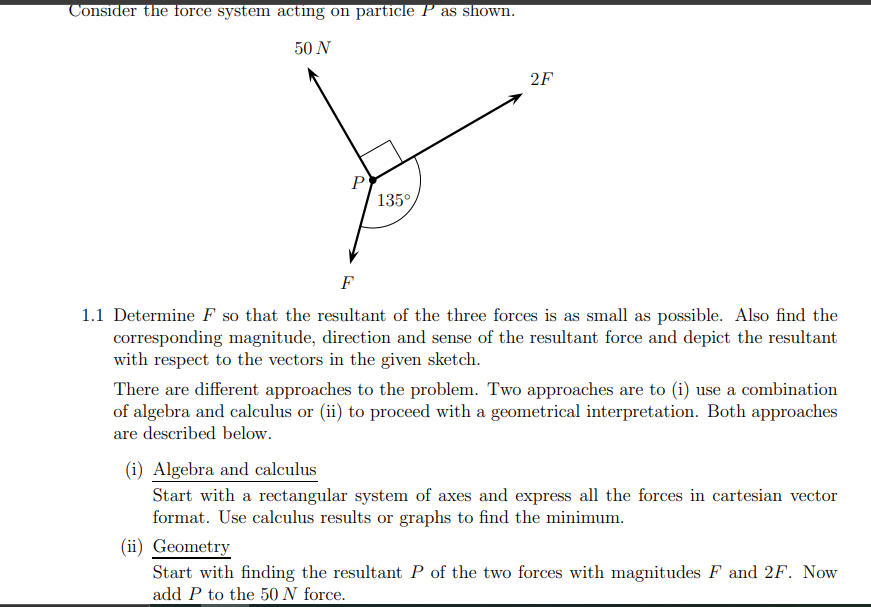Consider the force system acting on particle P as shown. 50 Ν 2F P 135° F 1.1 Determine F so that the resultant of the three forces is as small as possible. Also find the corresponding magnitude, direction and sense of the resultant force and depict the resultant with respect to the vectors in the given sketch. There are different approaches to the problem. Two approaches are to (i) use a combination of algebra and calculus or (ii) to proceed with a geometrical interpretation. Both approaches are described below. (i) Algebra and calculus Start with a rectangular system of axes and express all the forces in cartesian vector format. Use calculus results or graphs to find the minimum. (ii) Geometry Start with finding the resultant P of the two forces with magnitudes F and 2F. Now add P to the 50 N force.
Consider the force system acting on particle P as shown. 50 Ν 2F P 135° F 1.1 Determine F so that the resultant of the three forces is as small as possible. Also find the corresponding magnitude, direction and sense of the resultant force and depict the resultant with respect to the vectors in the given sketch. There are different approaches to the problem. Two approaches are to (i) use a combination of algebra and calculus or (ii) to proceed with a geometrical interpretation. Both approaches are described below. (i) Algebra and calculus Start with a rectangular system of axes and express all the forces in cartesian vector format. Use calculus results or graphs to find the minimum. (ii) Geometry Start with finding the resultant P of the two forces with magnitudes F and 2F. Now add P to the 50 N force.
University Physics Volume 1
18th Edition
ISBN:9781938168277
Author:William Moebs, Samuel J. Ling, Jeff Sanny
Publisher:William Moebs, Samuel J. Ling, Jeff Sanny
Chapter2: Vectors
Section: Chapter Questions
Problem 5CQ: Suppose you add two vectors A and B . What relative direction between them produces the resultant...
Related questions
Question
hello
may you please help me with this question.

Transcribed Image Text:Consider the force system acting on particle P as shown.
50 N
2F
135°
F
1.1 Determine F so that the resultant of the three forces is as small as possible. Also find the
corresponding magnitude, direction and sense of the resultant force and depict the resultant
with respect to the vectors in the given sketch.
There are different approaches to the problem. Two approaches are to (i) use a combination
of algebra and calculus or (ii) to proceed with a geometrical interpretation. Both approaches
are described below.
(i) Algebra and calculus
Start with a rectangular system of axes and express all the forces in cartesian vector
format. Use calculus results or graphs to find the minimum.
(ii) Geometry
Start with finding the resultant P of the two forces with magnitudes F and 2F. Now
add P to the 50 N force.
Expert Solution
This question has been solved!
Explore an expertly crafted, step-by-step solution for a thorough understanding of key concepts.
Step by step
Solved in 2 steps with 2 images

Knowledge Booster
Learn more about
Need a deep-dive on the concept behind this application? Look no further. Learn more about this topic, physics and related others by exploring similar questions and additional content below.Recommended textbooks for you

University Physics Volume 1
Physics
ISBN:
9781938168277
Author:
William Moebs, Samuel J. Ling, Jeff Sanny
Publisher:
OpenStax - Rice University

Principles of Physics: A Calculus-Based Text
Physics
ISBN:
9781133104261
Author:
Raymond A. Serway, John W. Jewett
Publisher:
Cengage Learning

University Physics Volume 1
Physics
ISBN:
9781938168277
Author:
William Moebs, Samuel J. Ling, Jeff Sanny
Publisher:
OpenStax - Rice University

Principles of Physics: A Calculus-Based Text
Physics
ISBN:
9781133104261
Author:
Raymond A. Serway, John W. Jewett
Publisher:
Cengage Learning